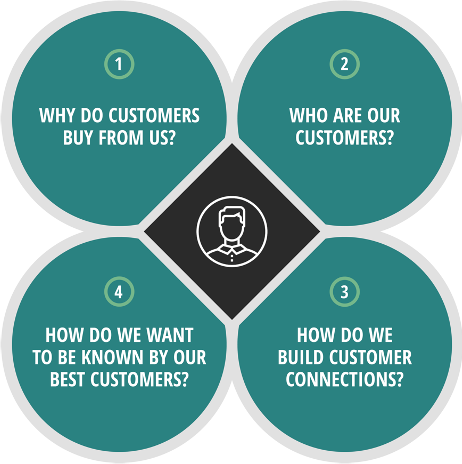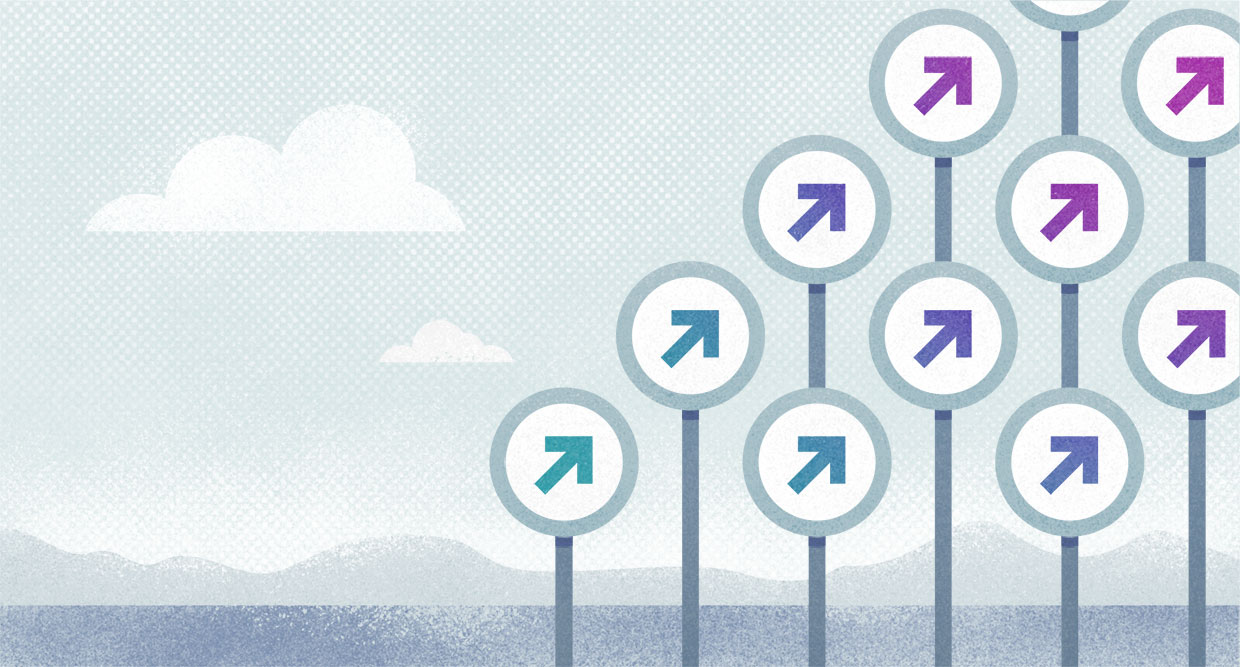Four Skills Leaders Need to Shape a Customer-Centric Future
Key Take-Aways:
- Leaders become more effective strategists when they (1) develop a point of view about the future, (2) Invite the savviest outsiders in, (3) harness uncertainty, and (4) create strategic traction.
- RBL’s customer-centricity model can help Strategists understand and shape customer-centric strategies.
- Leaders who separate signal from noise focus on information that matters most and are both analysts with empirical and structured data and anthropologists with observations and unstructured data.

Four Skills Leaders Need to Shape a Customer-Centric Future

Organizations that win are clearly able to see where they are today and create alignment around a direction for the future that will meet customers changing expectations while delivering the results investors and other stakeholders expect. And then, create a roadmap from Point A to Point B that the organization can execute. In today’s world, being able to imagine and work towards a “Point B“ feels harder than it has ever been.
As we talk with organizations around the world, they are doubling down on their investments in building leaders who combine vision and analytics to envision a future state that creates and responds to new and emerging opportunities.
One key element in building leaders in today’s environment is to build leaders who can answer with credibility and confidence the question: Where are we going? The following skills help leaders be more effective strategists in leading their teams and organizations.
Skill #1: Use Information Asymmetry to Develop a Point of View About the Future
Setting a direction for future competitiveness and growth requires strategists to look ahead and make predictions about what stakeholder needs will be and how to fulfill those needs best often before the customer even recognizes them. In order to stay ahead, strategists are driven by a quest for information asymmetry and new ways to compete.
As technology has enabled the proliferation of information, it has created a challenge and an opportunity for great leaders. With the flood of information now available in internal systems, emails, websites, social media, and other information channels, great leaders develop the ability to discern signals from the information. Signals are asymmetric information insights that have immediate consequences and that inform decisions. Leaders who separate signal from noise focus on information that matters most and are both analysts with empirical and structured data and anthropologists with observations and unstructured data.
With unique information insights, they move their organizations from benchmarking that discovers how they compare to others, to best practices that identify who is effective, to predictive analysis that explains why someone is effective to the guidance for impact that focuses information on what they can specifically do to improve. Traditionally, organizations had splintered data sets that showed up in isolated benchmarking reports about employees, customers, manufacturing processes, or financial performance. Many of these disparate data sets are combined to create dashboards or scorecards that provide alerts about what is happening. Looking ahead, some leading companies use data to predict and guide what should happen.
| TIME FRAME | ||||
|---|---|---|---|---|
| PAST | PRESENT | FUTURE | ||
| USE OF DATA | Intelligence and Insight | What happened? (Reporting) | What is happening now? (Scorecards, Dashboards) | What will happen (Extrapolation) |
| Intervention and Impact | How and how did it happen? (Modeling) | What’s the next best action? (Recommendation) | What is the best or worst that can happen? (Prediction) | |
Leaders who focus on information asymmetry access insights that enable them to move ahead of others to get first-mover advantages, foster innovation, adapt quickly to external changes, and prioritize key insights that focus their resources.
Skill #2: Invite Savviest Outsiders In
Strategic leaders develop a point of view about the future that resonates with external stakeholders (customers, investors, and communities), or what we call being "outside-in". Leaders succeed when customers are more likely to buy products and services and investors have increased confidence in future firm performance.
RBL’s customer-centricity model can help leaders build understanding and shape customer-centric strategies:
Figure 2: RBL Customer-Centricity Model

Why Do Customers Buy from Us? A customer value proposition defines the primary value we seek to offer our customers and defines why customers will choose to do business with your organization over your competitors. Whether it is because you are more efficient, reliable, or of higher quality, have better customer connectivity, or are more innovative, a clearly articulated and effectively delivered message creates value and increases distinctiveness.
Who Are Our Customers? Strategists create clarity about which customers will fuel growth. By knowing how to narrow your customers down into targeted, segmented groups, you are able to focus on the most important customers and best meet their needs. You also learn how to take your products or ideas and make them more valuable to those segments. The more you understand your customers and see their point of view, the more you are able to serve them and meet their expectations.
How Do We Build Customer Connections? You can build customer intimacy by moving from transactional patterns with your customers to partnering with them to help them solve particular needs and even begin to anticipate the potential needs and desires of your customers and offer solutions—sometimes before they even understand they have a need. Strategists move the organization from transactive interactions with key customer groups toward partnering and anticipating needs to build intimacy and increase impact.
How Do We Want to Be Known By Our Best Customers? A clearly articulated and consistently reinforced firm brand identity is the final and encompassing piece to customer-centricity. This external brand becomes the basis for creating the “right” internal culture. When a firm’s identity in the marketplace (e.g., known for innovation, quality, cost, or service) becomes the basis for culture, employees inside and customers outside focus on similar capabilities. These firms succeed in the marketplace because of the alignment of the workplace.
Strategists have a clear point of view about the customer value proposition and target customers and actively work to build customer connections and reinforce the firm brand identity at each customer (and employee) touchpoint.
Beyond customers, strategists also benefit from the input of investors and the local community. Attention to these voices adds to the intangible value of an organization. Inviting the savviest outsiders in means modeling customer-centricity in everything you do. While segmenting customers, engaging external stakeholders, and establishing a brand identity, you will disrupt your industry and become a valuable partner to your clients.
Skill #3: Harness Uncertainty and Involve the Organization
Strategists gather information from stakeholders inside the organization as well as those outside. Information about evolving customer needs and preferences often exists in the lowest levels in the organization–those who are interacting daily with customers, for example in retail outlets or customer service centers. Increasingly, data throughout the organization can provide important information about how the competitive environment and customer needs are evolving.
Since that cannot be known with certainty, they develop the skills to harness uncertainty. 'Harness' does not mean managing or taking away uncertainty, but recognizing it and finding ways to respond to it effectively. They understand that the future cannot be known but that they have a responsibility to develop probabilistic scenarios and make decisions and guide the organization towards the scenarios that are most likely and most beneficial to the organization’s external stakeholders. To harness uncertainty, leaders:
- Envision the future
- Guide choices
- Tame apprehension
- Regulate expectations
- Experiment nimbly
- Collaborate frequently
As they do this, they provide certainty for the organization. They understand that the more people at every level are involved in strategy discussions, the more likely they will be to be engaged in delivering and executing the strategy. Great leaders are constantly asking people throughout the organization to share what they know. They test possible future scenarios with leaders and are open to challenges and questions about how abstract future directions might be operationalized.
Skill #4: Create Strategic Traction
It is not enough to articulate a strategy. To create value, the strategy must be implemented. Great strategists create strategic traction, where employees at all levels understand where the company is going, remember it, act on it, and are excited by it.
How does senior leadership ensure that each member of the organization has a line of sight about how their personal work impacts the business? With the strategy in mind, leaders ensure they can fulfill the promises they’ve made to customers by building organizational capabilities and strategic storytelling.
Leaders focus on building the organizational capabilities that are necessary to execute the strategy. Some capabilities are defined by the growth strategy and customer value proposition. For example, a company like Wal-Mart or Micro-tel that competes on price will develop systems and processes and culture around efficiency while a company that competes on customer connection will develop systems and processes and culture around customer care. Additionally, organizational capabilities like collaboration or leadership can be deliberately cultivated to create added distinctiveness. Leaders identify these capabilities needed to execute the strategy and then sponsor or create the systems, processes, and culture that reinforce the capabilities.
Additionally, leaders tell stories that help people understand and commit to future directions. In the consistent retelling of the story, employees inside and investors and customers outside can resonate with the insights, emotions, and actions. When told with conviction, each stakeholder is able to grab hold of the story and get involved in their respective manner.
Conclusion
The old saying says, “If you fail to plan, you plan to fail.” Every company’s future depends on its ability to look to the future, set goals, and create the pathway to fulfill those goals. Using the best information available, great leaders engage customers, employees, and anyone else who matters to the process. They create the capabilities and stories that stretch the organization based on a realistic perspective about their technical and social capabilities.
If you are looking to build these skills in your leaders, we invite you to explore the Leadership Code® Academy.


